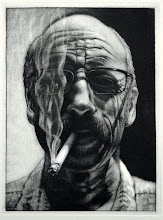Creativity is a way of both thinking and behaving with both subjectivity and objectivity. It's a combination of feeling and knowing between what we sense and what we know. When we're aware of both, when we embrace both, there is a sense of wholeness. Of course I don't think it's possible to have a perfect balance of both, and it's that imbalance that makes us unique to each other.
Our society, in general, is either subjective or objective; in fact, that split kind of typifies the individuals of our society. The objective person is a knower after the fact, the one who kind of senses the situation and then makes a determination based on that experience. The subjective person is sort of a here and now type, savoring the sensory experience and caring little for the conclusion.
When we combine the two, as I hope we all do, we gain more than both. We have a more natural conscious balance between extremes. It allows us to see ourselves from a more unique perspective and our wholeness becomes more apparent, more palpable. We can lead and follow, we can determine our goal and go toward it - - we can design the stimulus and experience the response.
Creativity is expressed in so many ways, infinite ways. Such as designing a brochure, or throwing, glazing, and firing a mug or a platter. Creativity has been expressed it the chairs we sit in, the benches we sit on, the orange tables in the studios, the colors of our walls, the patterns in the carpeting, where the little trees have been planted out by the 'lodges', the way we install exhibitions in the gallery, even how we light those exhibitions, and on and on. I even get creative when I cook, sometimes when I shave. When we each have an idea that we want realized, we're being creative. Sometimes our creative solutions may not be as strong as we'd like, but they're still our creative solutions; we're exercising our CREATIVITY.

6 comments:
Well said.
Thanks, Jay. I'm thinking that my classes next semester have to give more focus on 'creativity', what it means and how it functions in our lives. We can't get to the point of getting a degree in Fine Arts and not understand the nature of creativity and its force in our creative 'products".
Yes, yes. Thanks for starting and interesting and valuable discussion, Brian.
It is a valuable topic that doesn't get discussed enough. I have seen many times and more frequently over the past five or so years that students in the visual arts are relying more and more on the internet to satisfy their need for an idea for a class project. In that regard, creativity in the visual arts should become a more important focus of discussion. When we consider the amount of and rate of change in the last decade, particularly in the arts, the importance of creativity should be paramount. We are regularly trying to address opportunities and solutions to issues that didn't even exist when we started looking at a creative problem, they just manifest along the way, we create them in our working process. However, there are many who 'grab' ideas off of the internet and claim them as their own justifying that it's not the same any more because it was done in a different medium, or it's interpreted in a different color. Of course, I think that's hog-wash. One of the things we deal with that is so difficult is that for most creatives (all of us) consistent on-going creativity can be very elusive. I think much of that can be linked to our culture and the manner in which we and our children get educated. I recall many years ago when I was a kid, we had to be creative to entertain ourselves. Cardboard boxes became castles and sticks became swords. Today, my so many kids across our country have all the interactive toys that do all of the creating for them. They just pushes buttons and music is played, or voices talk to them and tell them the color of the button they just pushed. They're not very interested anymore in the box it came in.
Interesting... I couldn't agree more--about modern technology robbing young people of creativity. I remember agonizing over what to buy my little one for Christmas, spending way too much money on some tricked out techno-toy and then laughing my butt off as she totally ignored the toy and gleefully played for hours with the wrapping paper and the box it came in. So, perhaps it could be said that thinking "inside the box" is, after all, an important part of the creative process?
You may have hit on something, Allison. Thinking outside the box has become so much a part of our vernacular that the idea of doing so inside the box has earned a negative connotation. However, thinking creatively often requires a pretty tight space in order to define what the creative problem might be. So the origins of our creative thought might just well be inside the box, a metaphorical space were a problem can be examined from a lot of different perspectives. Once we get things defined, then we can tear the walls down and see what happens.
Post a Comment